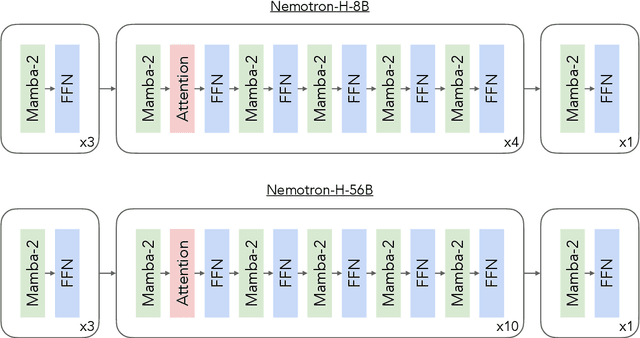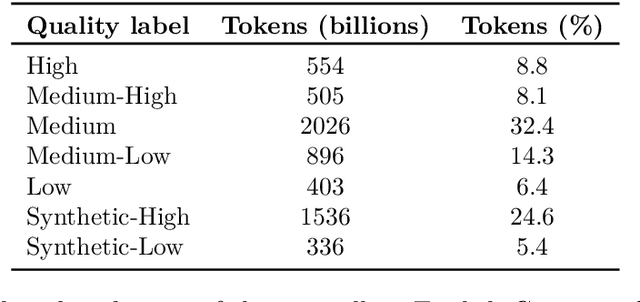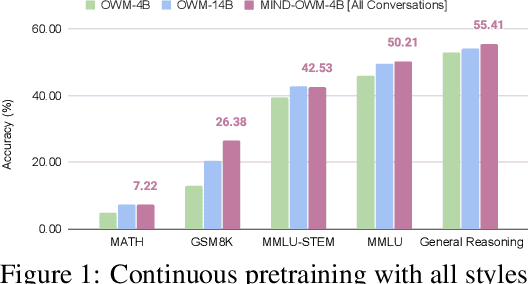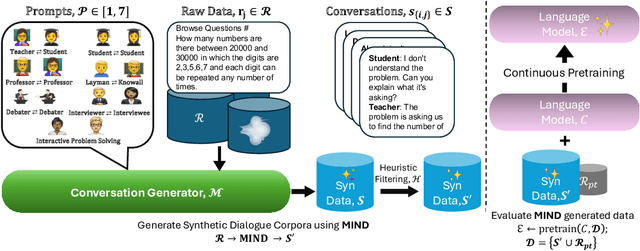Shrimai Prabhumoye
NVIDIA Nemotron Nano 2: An Accurate and Efficient Hybrid Mamba-Transformer Reasoning Model
Aug 21, 2025



Abstract:We introduce Nemotron-Nano-9B-v2, a hybrid Mamba-Transformer language model designed to increase throughput for reasoning workloads while achieving state-of-the-art accuracy compared to similarly-sized models. Nemotron-Nano-9B-v2 builds on the Nemotron-H architecture, in which the majority of the self-attention layers in the common Transformer architecture are replaced with Mamba-2 layers, to achieve improved inference speed when generating the long thinking traces needed for reasoning. We create Nemotron-Nano-9B-v2 by first pre-training a 12-billion-parameter model (Nemotron-Nano-12B-v2-Base) on 20 trillion tokens using an FP8 training recipe. After aligning Nemotron-Nano-12B-v2-Base, we employ the Minitron strategy to compress and distill the model with the goal of enabling inference on up to 128k tokens on a single NVIDIA A10G GPU (22GiB of memory, bfloat16 precision). Compared to existing similarly-sized models (e.g., Qwen3-8B), we show that Nemotron-Nano-9B-v2 achieves on-par or better accuracy on reasoning benchmarks while achieving up to 6x higher inference throughput in reasoning settings like 8k input and 16k output tokens. We are releasing Nemotron-Nano-9B-v2, Nemotron-Nano12B-v2-Base, and Nemotron-Nano-9B-v2-Base checkpoints along with the majority of our pre- and post-training datasets on Hugging Face.
Nemotron-CC-Math: A 133 Billion-Token-Scale High Quality Math Pretraining Dataset
Aug 20, 2025Abstract:Pretraining large language models (LLMs) on high-quality, structured data such as mathematics and code substantially enhances reasoning capabilities. However, existing math-focused datasets built from Common Crawl suffer from degraded quality due to brittle extraction heuristics, lossy HTML-to-text conversion, and the failure to reliably preserve mathematical structure. In this work, we introduce Nemotron-CC-Math, a large-scale, high-quality mathematical corpus constructed from Common Crawl using a novel, domain-agnostic pipeline specifically designed for robust scientific text extraction. Unlike previous efforts, our pipeline recovers math across various formats (e.g., MathJax, KaTeX, MathML) by leveraging layout-aware rendering with lynx and a targeted LLM-based cleaning stage. This approach preserves the structural integrity of equations and code blocks while removing boilerplate, standardizing notation into LaTeX representation, and correcting inconsistencies. We collected a large, high-quality math corpus, namely Nemotron-CC-Math-3+ (133B tokens) and Nemotron-CC-Math-4+ (52B tokens). Notably, Nemotron-CC-Math-4+ not only surpasses all prior open math datasets-including MegaMath, FineMath, and OpenWebMath-but also contains 5.5 times more tokens than FineMath-4+, which was previously the highest-quality math pretraining dataset. When used to pretrain a Nemotron-T 8B model, our corpus yields +4.8 to +12.6 gains on MATH and +4.6 to +14.3 gains on MBPP+ over strong baselines, while also improving general-domain performance on MMLU and MMLU-Stem. We present the first pipeline to reliably extract scientific content--including math--from noisy web-scale data, yielding measurable gains in math, code, and general reasoning, and setting a new state of the art among open math pretraining corpora. To support open-source efforts, we release our code and datasets.
Prismatic Synthesis: Gradient-based Data Diversification Boosts Generalization in LLM Reasoning
May 26, 2025Abstract:Effective generalization in language models depends critically on the diversity of their training data. Yet existing diversity metrics often fall short of this goal, relying on surface-level heuristics that are decoupled from model behavior. This motivates us to ask: What kind of diversity in training data actually drives generalization in language models -- and how can we measure and amplify it? Through large-scale empirical analyses spanning over 300 training runs, carefully controlled for data scale and quality, we show that data diversity can be a strong predictor of generalization in LLM reasoning -- as measured by average model performance on unseen out-of-distribution benchmarks. We introduce G-Vendi, a metric that quantifies diversity via the entropy of model-induced gradients. Despite using a small off-the-shelf proxy model for gradients, G-Vendi consistently outperforms alternative measures, achieving strong correlation (Spearman's $\rho \approx 0.9$) with out-of-distribution (OOD) performance on both natural language inference (NLI) and math reasoning tasks. Building on this insight, we present Prismatic Synthesis, a framework for generating diverse synthetic data by targeting underrepresented regions in gradient space. Experimental results show that Prismatic Synthesis consistently improves model performance as we scale synthetic data -- not just on in-distribution test but across unseen, out-of-distribution benchmarks -- significantly outperforming state-of-the-art models that rely on 20 times larger data generator than ours. For example, PrismMath-7B, our model distilled from a 32B LLM, outperforms R1-Distill-Qwen-7B -- the same base model trained on proprietary data generated by 671B R1 -- on 6 out of 7 challenging benchmarks.
Llama-Nemotron: Efficient Reasoning Models
May 02, 2025Abstract:We introduce the Llama-Nemotron series of models, an open family of heterogeneous reasoning models that deliver exceptional reasoning capabilities, inference efficiency, and an open license for enterprise use. The family comes in three sizes -- Nano (8B), Super (49B), and Ultra (253B) -- and performs competitively with state-of-the-art reasoning models such as DeepSeek-R1 while offering superior inference throughput and memory efficiency. In this report, we discuss the training procedure for these models, which entails using neural architecture search from Llama 3 models for accelerated inference, knowledge distillation, and continued pretraining, followed by a reasoning-focused post-training stage consisting of two main parts: supervised fine-tuning and large scale reinforcement learning. Llama-Nemotron models are the first open-source models to support a dynamic reasoning toggle, allowing users to switch between standard chat and reasoning modes during inference. To further support open research and facilitate model development, we provide the following resources: 1. We release the Llama-Nemotron reasoning models -- LN-Nano, LN-Super, and LN-Ultra -- under the commercially permissive NVIDIA Open Model License Agreement. 2. We release the complete post-training dataset: Llama-Nemotron-Post-Training-Dataset. 3. We also release our training codebases: NeMo, NeMo-Aligner, and Megatron-LM.
NEMOTRON-CROSSTHINK: Scaling Self-Learning beyond Math Reasoning
Apr 15, 2025Abstract:Large Language Models (LLMs) have shown strong reasoning capabilities, particularly when enhanced through Reinforcement Learning (RL). While prior work has successfully applied RL to mathematical reasoning -- where rules and correctness are well-defined -- generalizing these methods to broader reasoning domains remains challenging due to limited data, the lack of verifiable reward structures, and diverse task requirements. In this work, we propose NEMOTRON-CROSSTHINK, a framework that systematically incorporates multi-domain corpora, including both synthetic and real-world question-answer pairs, into RL training to improve generalization across diverse reasoning tasks. NEMOTRON-CROSSTHINK addresses key challenges by (1) incorporating data from varied sources spanning STEM, humanities, social sciences, etc.; (2) applying structured templates (e.g., multiple-choice and open-ended) to control answer-space complexity; (3) filtering for verifiable answers; and (4) optimizing data blending strategies that utilizes data from multiple sources effectively. Our approach enables scalable and verifiable reward modeling beyond mathematics and demonstrates improved accuracies on both math (MATH-500: +30.1%, AMC23:+27.5%) and non-math reasoning benchmarks (MMLU-PRO: +12.8%, GPQA-DIAMOND: +11.3%, AGIEVAL: +15.1%, SUPERGPQA: +3.8%). Moreover, NEMOTRON-CROSSTHINK exhibits significantly improved response efficiency -- using 28% fewer tokens for correct answers -- highlighting more focused and effective reasoning. Through NEMOTRON-CROSSTHINK, we demonstrate that integrating multi-domain, multi-format data in RL leads to more accurate, efficient, and generalizable LLMs.
Nemotron-H: A Family of Accurate and Efficient Hybrid Mamba-Transformer Models
Apr 10, 2025



Abstract:As inference-time scaling becomes critical for enhanced reasoning capabilities, it is increasingly becoming important to build models that are efficient to infer. We introduce Nemotron-H, a family of 8B and 56B/47B hybrid Mamba-Transformer models designed to reduce inference cost for a given accuracy level. To achieve this goal, we replace the majority of self-attention layers in the common Transformer model architecture with Mamba layers that perform constant computation and require constant memory per generated token. We show that Nemotron-H models offer either better or on-par accuracy compared to other similarly-sized state-of-the-art open-sourced Transformer models (e.g., Qwen-2.5-7B/72B and Llama-3.1-8B/70B), while being up to 3$\times$ faster at inference. To further increase inference speed and reduce the memory required at inference time, we created Nemotron-H-47B-Base from the 56B model using a new compression via pruning and distillation technique called MiniPuzzle. Nemotron-H-47B-Base achieves similar accuracy to the 56B model, but is 20% faster to infer. In addition, we introduce an FP8-based training recipe and show that it can achieve on par results with BF16-based training. This recipe is used to train the 56B model. All Nemotron-H models will be released, with support in Hugging Face, NeMo, and Megatron-LM.
Retro-Search: Exploring Untaken Paths for Deeper and Efficient Reasoning
Apr 06, 2025



Abstract:Large reasoning models exhibit remarkable reasoning capabilities via long, elaborate reasoning trajectories. Supervised fine-tuning on such reasoning traces, also known as distillation, can be a cost-effective way to boost reasoning capabilities of student models. However, empirical observations reveal that these reasoning trajectories are often suboptimal, switching excessively between different lines of thought, resulting in under-thinking, over-thinking, and even degenerate responses. We introduce Retro-Search, an MCTS-inspired search algorithm, for distilling higher quality reasoning paths from large reasoning models. Retro-Search retrospectively revises reasoning paths to discover better, yet shorter traces, which can then lead to student models with enhanced reasoning capabilities with shorter, thus faster inference. Our approach can enable two use cases: self-improvement, where models are fine-tuned on their own Retro-Search-ed thought traces, and weak-to-strong improvement, where a weaker model revises stronger model's thought traces via Retro-Search. For self-improving, R1-distill-7B, fine-tuned on its own Retro-Search-ed traces, reduces the average reasoning length by 31.2% while improving performance by 7.7% across seven math benchmarks. For weak-to-strong improvement, we retrospectively revise R1-671B's traces from the OpenThoughts dataset using R1-distill-32B as the Retro-Search-er, a model 20x smaller. Qwen2.5-32B, fine-tuned on this refined data, achieves performance comparable to R1-distill-32B, yielding an 11.3% reduction in reasoning length and a 2.4% performance improvement compared to fine-tuning on the original OpenThoughts data. Our work counters recently emergent viewpoints that question the relevance of search algorithms in the era of large reasoning models, by demonstrating that there are still opportunities for algorithmic advancements, even for frontier models.
Maximize Your Data's Potential: Enhancing LLM Accuracy with Two-Phase Pretraining
Dec 18, 2024



Abstract:Pretraining large language models effectively requires strategic data selection, blending and ordering. However, key details about data mixtures especially their scalability to longer token horizons and larger model sizes remain underexplored due to limited disclosure by model developers. To address this, we formalize the concept of two-phase pretraining and conduct an extensive systematic study on how to select and mix data to maximize model accuracies for the two phases. Our findings illustrate that a two-phase approach for pretraining outperforms random data ordering and natural distribution of tokens by 3.4% and 17% on average accuracies. We provide in-depth guidance on crafting optimal blends based on quality of the data source and the number of epochs to be seen. We propose to design blends using downsampled data at a smaller scale of 1T tokens and then demonstrate effective scaling of our approach to larger token horizon of 15T tokens and larger model size of 25B model size. These insights provide a series of steps practitioners can follow to design and scale their data blends.
MIND: Math Informed syNthetic Dialogues for Pretraining LLMs
Oct 15, 2024



Abstract:The utility of synthetic data to enhance pretraining data quality and hence to improve downstream task accuracy has been widely explored in recent large language models (LLMs). Yet, these approaches fall inadequate in complex, multi-hop and mathematical reasoning tasks as the synthetic data typically fails to add complementary knowledge to the existing raw corpus. In this work, we propose a novel large-scale and diverse Math Informed syNthetic Dialogue (MIND) generation method that improves the mathematical reasoning ability of LLMs. Specifically, using MIND, we generate synthetic conversations based on OpenWebMath (OWM), resulting in a new math corpus, MIND-OWM. Our experiments with different conversational settings reveal that incorporating knowledge gaps between dialog participants is essential for generating high-quality math data. We further identify an effective way to format and integrate synthetic and raw data during pretraining to maximize the gain in mathematical reasoning, emphasizing the need to restructure raw data rather than use it as-is. Compared to pretraining just on raw data, a model pretrained on MIND-OWM shows significant boost in mathematical reasoning (GSM8K: +13.42%, MATH: +2.30%), including superior performance in specialized knowledge (MMLU: +4.55%, MMLU-STEM: +4.28%) and general purpose reasoning tasks (GENERAL REASONING: +2.51%).
Data, Data Everywhere: A Guide for Pretraining Dataset Construction
Jul 08, 2024Abstract:The impressive capabilities of recent language models can be largely attributed to the multi-trillion token pretraining datasets that they are trained on. However, model developers fail to disclose their construction methodology which has lead to a lack of open information on how to develop effective pretraining sets. To address this issue, we perform the first systematic study across the entire pipeline of pretraining set construction. First, we run ablations on existing techniques for pretraining set development to identify which methods translate to the largest gains in model accuracy on downstream evaluations. Then, we categorize the most widely used data source, web crawl snapshots, across the attributes of toxicity, quality, type of speech, and domain. Finally, we show how such attribute information can be used to further refine and improve the quality of a pretraining set. These findings constitute an actionable set of steps that practitioners can use to develop high quality pretraining sets.
 Add to Chrome
Add to Chrome Add to Firefox
Add to Firefox Add to Edge
Add to Edge